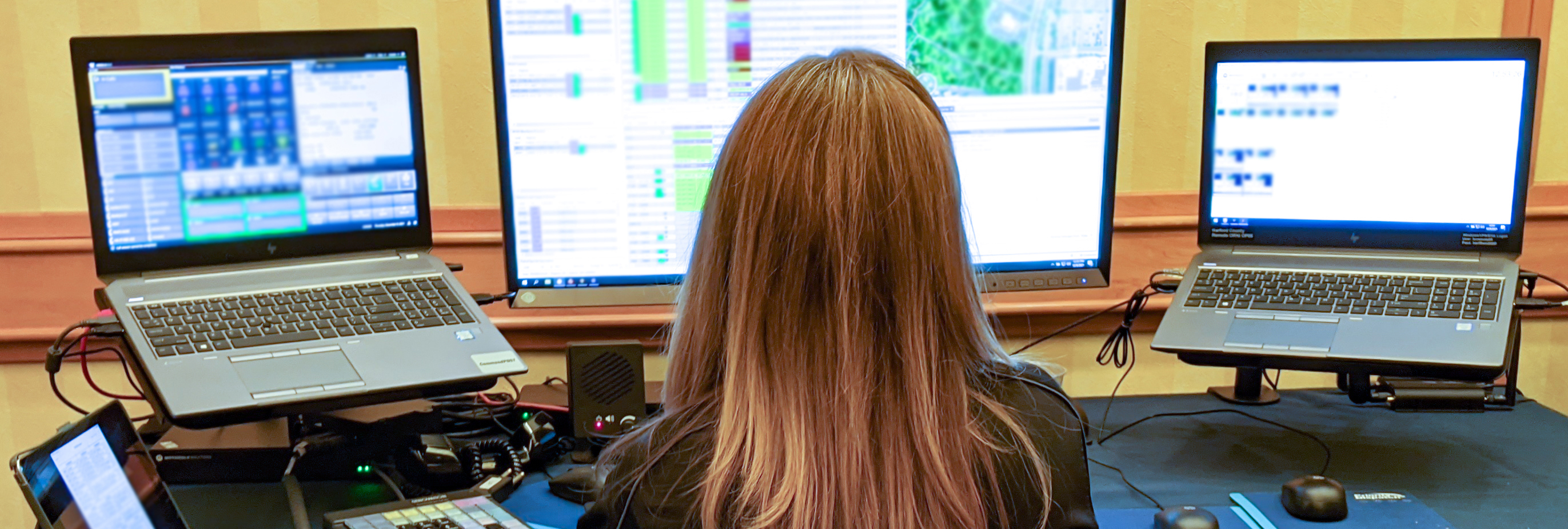One thing the 9-1-1 community learned from the pandemic was the need to plan for alternate ways to work. Rather than be tied to workstations at fixed locations, 9-1-1 telecommunicators need flexibility to remotely take, dispatch, and supervise calls. In December 2021, Maryland telecommunicators put FirstNet to the test, demonstrating the network’s connectivity and reliability during remote operations.
Remote call-taking expo
Six counties from across Maryland staged a 9-1-1 expo with live call-taking from a remote and crowded location using FirstNet. The expo was conducted at the Maryland Association of Counties’ winter conference. 9-1-1 specialists from across the state set up call equipment in a large conference room. Of the six counties participating, three agencies were taking live calls from their home counties. The other three agencies were remotely monitoring calls happening at their counties’ emergency communication centers.
FirstNet provided the connectivity from the conference venue back to the local 9-1-1 centers. In the weeks leading up to the event, the participating agencies worked with FirstNet teams to ensure they had coverage, speed, and backhaul for the event.
The results
The expo was a success. With 1,500 attendees at the conference, the biggest challenge reported by the telecommunicators was background noise from the crowds. The technology worked as if they were sitting in their home centers.
“We were able to successfully demonstrate that you can take 9-1-1 calls from anywhere,” said Ross Coates, communications manager for the Harford County 9-1-1 Center. “Today, using FirstNet as our internet service provider or backhaul to connect back to our equipment in our local 9-1-1 centers, we processed many 9-1-1 calls.”
Jennifer Webster is a public safety supervisor with the Harford County Department of Emergency Services. She was at the expo taking live calls from her home county and was pleased with the results. “It went great — everything worked seamlessly,” she said. “And the dispatchers in Harford County had no idea I was the one who took the call from two hours away.”
Return on investment
The expo also served as an opportunity to show Maryland officials the return on their investments. A statewide initiative from the early days of COVID-19 sought to establish the tools and capabilities for remote 9-1-1 operations. The state funded a project to have mobile command posts deployed to centers throughout the state. The expo at the conference demonstrated the success of that initiative.
As elected officials visited the expo, they were surprised at the technology and that multiple counties were fielding 9-1-1 calls from one conference room. Their reaction? “Utter amazement. People are astounded at what we're doing in that room,” said Coates.
“This is a revolutionary technology and we're really happy that we can demonstrate it to all the folks here today,” said Kevin Kinnally, legislative director with the Maryland Association of Counties. “It’s a way for them to see — in action — what their support has meant and what it means for the people on the front lines. This shows the technology that's out there and how amazing it is and what it can do to ultimately save lives across the state and hopefully across the country.”
The case for remote operations
Why are remote operations critical to 9-1-1 centers? The demands of the pandemic crystallized the need for alternative solutions to in-person, fully-staffed emergency communication centers. But COVID-19 is not the only driving force. Remote operations are an important part of disaster preparedness.
For example, during incidents of extreme weather, staff may not be able to physically get to the emergency communication center. One participant recalled having to get a ride from the National Guard in Humvees when snow made the roads impassable for regular vehicles. Another participant noted that, in advance of a forecasted ice storm, equipment was pre-deployed to personnel so they could take calls remotely if needed.
Remote 9-1-1 operations are becoming critical elements of preparedness efforts. “It helps to enhance our continuity of operations plan. It helps to better serve residents in our communities and diversify where our workforce is at,” said Coates.




















